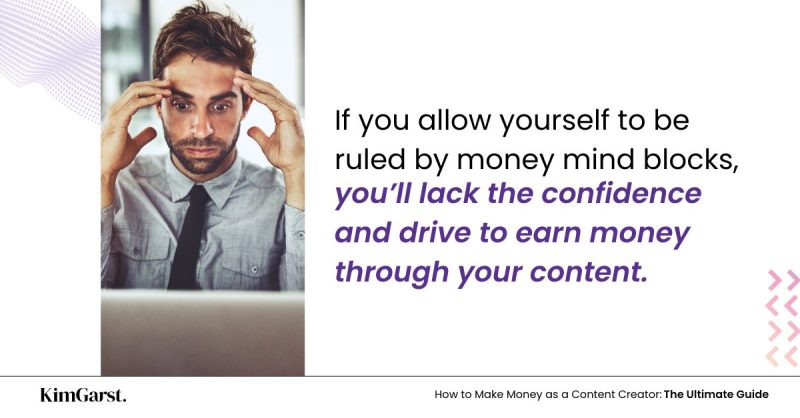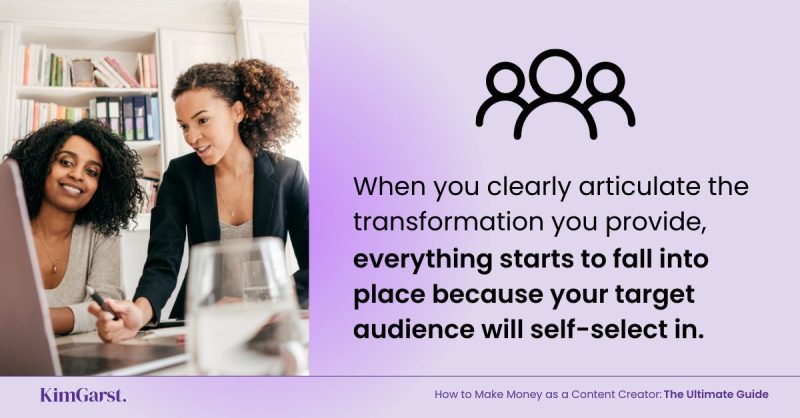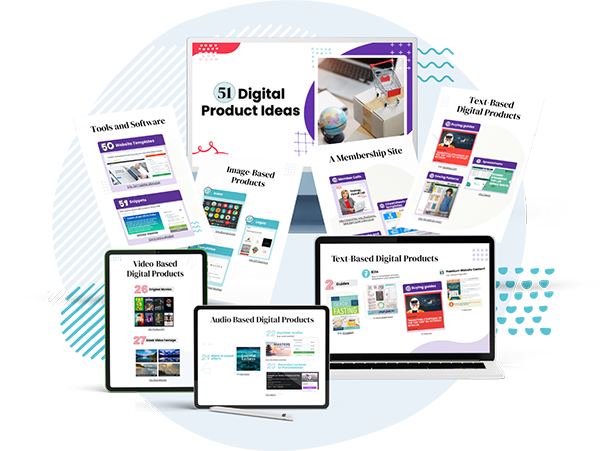There are more content creators out there than ever before. In fact, it’s estimated there are now over 200 MILLION content creators worldwide today. And honestly, I think this number is way higher…because if you’re online and sharing “content”, you’re a content creator!
But here’s the rub: with so many people creating and sharing content online, it’s extremely easy for your content to get lost in the shuffle. And this probably leaves you asking the question: how do I make money as a content creator?
I’ve been a full-time content creator for x years, and have been able to generate $x million from that content. And I want to let you in on the #1 secret of how to make money as a content creator: authority.
Authority is defined as the ability to influence people. In the context of content creation, it means establishing yourself as an authority in your field so people trust you and come to see you as an expert. Once people trust you and see you as an expert, they will be far more likely to buy what you’re selling.
And this is the key to making money as a content creator!
In this post I’m going to share a 9-part framework that will help you build your authority so you can start earning money as a content creator…fast.
How to Make Money as a Content Creator (Please link to each section below)
- Develop a money mindset
- Come up with a clear message
- Build an authority website
- Create a high-converting lead magnet
- Build a list that helps you profit
- Pre-purpose your content
- Build an audience on social media
- Engage in influencer marketing
- Use affiliate marketing
How to Make Money as a Content Creator: 9 Strategies or “Pillars”
Following are the nine steps or “pillars” of my Authority Creator framework. Implementing these steps will help establish you as an authority in your field and allow you to start earning money from that authority.
Strategy 1: Develop a Money Mindset
Your money mindset has a direct effect on how much money you’ll make as a content creator.
If you allow yourself to be ruled by money mind blocks, you’ll lack the confidence and drive to earn money through your content.
Money mindset blocks can be internal thoughts like “I don’t deserve to make lots of money,” or “Wanting to make more money is selfish.”
However, money blocks can also be external, coming from the people around us. And it’s these external blocks that can often be the most discouraging and counterproductive. Some examples of external money blocks might be your significant other saying, “You’re crazy to think you can make money from your blog,” or your best friend saying, “I know you have fun making videos, but it will never be more than a hobby.”
If you believe these thoughts and let them guide you, I guarantee you will never earn a living as a content creator!
Instead of being ruled by money mind blocks, you need to practice a profit mindset.
To develop a profit mindset, it’s important to consider two questions.
Question 1: What do I want my life as a content creator to look like?
Get really clear on the lifestyle you want. This means thinking about how many hours you want to work and what you want your day-to-day life as a content creator to look like. And perhaps most importantly, it means determining how much money you want to earn as a content creator. This will be your financial goal.
Question 2: Does my financial goal match up with my business model?
Once you’ve determined your financial goal, you need to make sure your business model will actually help you meet that goal.
For instance, let’s say your financial goal is to earn $10K/month. If you’re selling a product for $27, this means you’ll need to sell 370 units/month ($27 x 370 = $10K). For this scenario to work, you’ll either need a huge audience, or you’ll need to pay for traffic (and keep in mind the cost of traffic can come close to your sale price, meaning your profit margins can be SLIM).
So, would it make more sense to sell a $5K product, so you only have to sell two units? Spoiler alert: YES, it does make more sense!
To sum up, make sure your financial goals and your business model “play together.” This will be the key to developing a profit money mindset that helps you make money as a content creator.
Want more help with developing your money mindset? You can learn how to develop a money mindset here (link to subtopic post once it’s live).
Strategy 2: Come Up with a Clear Message
When people read or view your content, they should immediately understand what you’re offering.
To articulate your offer in a way that will capture the attention of your people, here’s the critical question you need to answer: what is the transformation you help people achieve?
Before you create even one more piece of content, take some time to get crystal clear on the answer to this question.
Articulating this transformation will show your people exactly how you can help them get from point A (where they are now) to point B (where they want to be).
Some examples of transformations could be helping your clients:
- Land their first lucrative freelancing gig: Going from the exhausting day-to-day hustle of looking for work, to spending their days actually working and earning a good income.
- Lose weight and get healthy: Going from worrying about their health all the time, to knowing they are healthy and having energy to do the things they want to do.
- Feel confident in setting limits with their kids: Going from doling out punishments, to setting firm boundaries without yelling or punishing.
When you clearly articulate the transformation you provide, everything starts to fall into place because your target audience will self-select in.
They will recognize themselves and their problem in your messaging; and because they see how you can help them solve their problem, buying your product will be a no-brainer.
Once you’ve nailed your messaging, creating content for your business becomes so much easier.
Your transformational message essentially becomes your one-liner. It becomes the message you use in every single piece of content you create: in your emails, your social media, and on your website.
Everything flows from this messaging, making it crystal clear to your people how you can help them…and this is ultimately what will result in leads and sales.Want to know more? Discover the steps to creating your own clearer brand messaging here.
Strategy 3: Build an Authority Website
Once you’ve developed a clear brand message, you should use this messaging across your entire website: on your homepage, sale pages, opt-in pages, and in your blog posts.
This will be the key to having a website that’s designed to profit.
A good rule of thumb is that visitors to your website need to know in 3 seconds or less that you understand the transformation they’re looking for.
Custom graphic idea: “Your website visitors need to know in 3 seconds or less that you understand the transformation they’re looking for.”
Not sure if you have an authority website?
Here’s a good question to ask yourself: does your website bring in leads and sales every single day?
If the answer is no, you don’t have an authority website!
Here is a simple set of questions that will get you on the right path to having an authority website.
Question #1: What is it that you offer? Is it immediately clear to your website visitors what your product or service is? If people need to hunt and peck around your site to figure this out, you don’t have an authority website.
Question #2: What value does your product or service add to your prospect’s life? What problem do you help them solve? What question do you answer for them? Is this clear in your messaging?
Question #3: How do people get your product or service? Is it obvious how people can take the next step? How they can book a discovery call, get a free consult, or work with you? Have you laid out a clear customer journey or path? If not, you don’t have an authority website.
Keep this key point in mind: your website copy shouldn’t be about you, it should be about your person and the problem you solve for them.
That said, you also want to establish yourself as an authority in your field. This doesn’t mean listing off all your awards and accolades, as this can come across as bragging, and can actually serve to alienate your people.
Instead, you want to showcase your expertise and your results, showing how you’ve helped others achieve transformation.
Need help creating an authority website? Learn how to make a website more authoritative here.
Strategy 4: Create a High-Converting Lead Magnet
This is the #1 problem I see content creators struggling with. They expect people to come to their website and immediately buy their product or book a sales call. And while this can certainly happen, most people will need to be nurtured over time before they make a purchase.
This is why it’s so important to have a killer lead gen in place. Your lead gen can be free or low cost, and can be an eBook, guide, video series, worksheet – the format doesn’t really matter. The key is that the lead gen will show your target audience you understand their problem, and that you can help them solve it.
Custom image idea: 10 Types of Effective Lead Gens
- eBook
- Guide
- Video series
- Worksheet
- Mini-course
- Cheat sheet
- Whitepaper
- Free demo
- Webinar
- Checklist
Now, this won’t be the big problem your primary offer helps them solve. Instead, you will help them achieve a smaller transformation that must take place before they can achieve the bigger one.
For instance, if your primary offer is a group fitness coaching program that helps people get healthy over a period of 6 months, your lead gen might teach people how to lose 5 pounds in a month. Once you show them you can help them achieve the smaller transformation (losing 5 pounds), they are far more likely to buy your main product offering.
A word on lead magnets: your goal shouldn’t be to create a lead gen that everyone wants! It should be carefully designed to be attractive to the people who will want to buy your product. For instance, if you offer to give away an iPad to one lucky email subscriber, you’ll probably get a lot of new subscribers! However, these subscribers are unlikely to be interested in your product, and no amount of nurturing or relationship-building is going to lead to a sale.Need help creating your own high-converting lead gen? Check out my lead generation survival guide for a step-by-step plan.
Strategy 5: Build a Profitable Email List.
I often see business owners struggle with growing a profitable email list. They work hard to get people onto their list, but then aren’t sure how to move those people from subscribers to customers.
To do this, you need to have what we call a content flywheel.
When done right, this flywheel acts as a self-propelling lead machine that will create a steady stream of leads and sales for your business.
It will allow you to build relationships with those on your list, leading to multiple conversions over time, rather than just one-off sales.
Compare this to what I see many business owners doing: having one lead gen that leads to one purchase!
This is a dead-end strategy, and one that really doesn’t offer much value to your people.
Instead, you’ll set up your content flywheel so your emails help build relationships over time. This will increase that “know, like, trust” factor, so that when you are ready to sell, your people are much more likely to buy.
Need more help? Find out how to build an email list from scratch here.
Strategy 6: Pre-purpose your content.
Each piece of content you create needs to have a purpose. I call this “pre-purposing.” Pre-purposing will involve creating content around two main questions.
Custom graphic idea:
2 questions to ask to create content that converts:
1. What is my person looking for?
2: What does my person need to believe to make a buying decision?
Question #1: What is my person looking for?
Each piece of content you create should be focused on the problem your prospects are
looking to solve. You’ll use the words and phrases your people are searching for; not only
so your content gets found more easily, but so your people read or view your content and
immediately say, “Yes! They’re talking to me!” Targeting these key terms is particularly
important if you’re creating content for YouTube, as this will be the primary way people find
you.
Of course, it’s not enough to simply use the key phrases people are using to describe their problem. You’ll also want to show your people that you have the solution to that problem.
Question #2: What does my person need to believe before they’re ready to make a buying decision?
What holds people back from actually making a purchase? Do they need a better understanding of the full scope of their problem? (e.g., all the ways this problem negatively impacts their lives). Do they need to be convinced that you’re the one who can help solve their problem? Do they need some kind of guarantee in order to reduce the risk they feel about making a purchase?
Whatever is getting in the way of your people buying from you, don’t be afraid to address this head-on in your content. This will be the key to creating content that actually leads to sales.
When it comes down to it, this strategy is all about being intentional with your content, not just throwing stuff against the wall to see what sticks.
And as mentioned previously, this will mean building out your content flywheel in a very purposeful way. This will be the key to creating content that actually converts, over and over again.
Still curious? Learn how to create content that attracts the right people.
Strategy 7: Build an audience on social media
Are you using social media every day but find it’s not really leading to sales? Having conversations on Twitter, Instagram or Facebook is great, but only if these conversations are happening with the right people, and only if they are driving sales.
To determine if you’re talking to the right people, ask yourself: Am I talking to people who are actually interested in what I have to offer? Or am I just passing the time having conversations with people who will never actually buy from me?
In order to profit from conversations on social media, you’ll need to:
- Find the right people to have conversations with,
- Build value through serving the right people in the right way, and
- Nurture those relationships in a way that ultimately results in sales.
Custom graphic idea:
3 Keys to Effective Social Selling
- Find the right people to have conversations with
- Build value by serving them in the right way
- Nurture those relationships in a way that leads to sales
This isn’t about being gimmicky or manipulative. This is about finding and connecting with the people who will actually benefit from your products or services, rather than wasting time connecting with those who don’t actually need your help.
A question I often get asked is, “Do I have to send DM’s when connecting with people on social media?”
This is a fair question! There’s no doubt that sending DM’s has the potential to be spammy. However, when done right, these one-on-one conversations can lead to deeper, more authentic relationships that actually adds value to your people’s lives.
For more help with this, go here to learn how to build an audience on social media.
Strategy 8: Engage in Influencer Marketing
“Influencer” is a term used a lot these days, and for good reason: the influencer marketing model remains one of the best ways for creators to generate revenue through their content.
Many content creators think they have to have a huge community in order to be an influencer. However, this couldn’t be further from the truth!
Many brands are now looking to work with micro-influencers: influencers with 500-1,000 followers. This is because savvy brands have figured out that influencers with smaller communities have much higher reach than those with really big communities.
Micro-influencers also tend to have more clout with their communities, and to receive more engagement on their posts and videos. This is because micro-influencers are able to connect in a more personal, and even one-on-one way.
If you’re thinking of monetizing your content through being an influencer, some of the questions you may struggle with include:
- How do I price my services in a way that is competitive, but that also values what I have to offer?
- How do I find brands who are looking to work with micro-influencers?
- Once I find these brands, how exactly do I pitch them?
Being able to answer these questions will be the key to using influencer marketing to make money as a content creator.
Need more help? Find out how to make money as an influencer.
Strategy 9: Use Affiliate Marketing
More than ever before, affiliate marketing is closely tied to influencer marketing. Many big brands have now created influencer programs just for content creators. For instance, Amazon and Walmart now both have influencer programs, and even Target is launching one soon.
Many of these programs give you a customized URL you can direct your people to, allowing you to add videos, shoppable pics and even livestreams.
These influencer programs are amazing for content creators, because they’re one of the easiest ways to make money before you have your own product or service.
Custom graphic idea: “Influencer programs are amazing for content creators, because they’re one of the easiest ways to make money before you have your own product or service.”
These programs are especially great if you have a large audience. This is because even though the commission rates tend to be fairly low (generally around 1-4% per sale), you can make up for this in volume.
Piqued your interest? Find out how to make money through affiliate marketing.
How to Earn Money Online as a Content Creator: FAQ’s
Following is a list of the questions I get asked most often about how to earn money as a content creator. Keep checking back as we will continually be adding new questions and answers.
Can we structure this section as questions with an arrow to expand the answers?
What is a content creator?
A content creator is anyone who produces content for other people to consume. This content can be for educational, informational or entertainment purposes.
Most of the time when we use the term content creation, we’re referring to online content. 9 common types of online content include:
- Blog posts
- Videos
- Social media posts
- eBooks
- Webinars
- Online courses
- Membership sites
- Podcasts
- Email newsletters
How do I become a content creator?
Anyone with access to a computer or smartphone can become a content creator. If you can create content, you’re a content creator!
However, to actually make money as a content creator, you’ll want to use the 9 strategies or “pillars” outlined in this post. As you implement these strategies you will build up your authority and be able to earn money as a content creator.
What are the different types of content creators?
There are many different types of content creators. 7 of the most common types of content creators are:
- Bloggers
- Videographers/YouTubers
- Social media influencers
- Podcasters
- Course creators
- Website content writers (e.g., someone who creates homepage and landing page content)
- Streamers (e.g., those who stream video game content)
How much does a content creator earn?
On average, content creators earn $48,664 per year in the United States. However, keep in mind this is just the average. It is possible to earn much more as a content creator if you have the knowledge, skills and tools to do so.
For instance, a recent report shows that over 20% of content creators earn $50K+/year. It is likely that these content creators have some combination of experience, expertise and access to strategies that have been proven to drive leads and sales.
How does a content creator get paid?
There are many possible content monetization strategies content creators can utilize. 12 of the most popular content monetization strategies include:
- Influencer marketing
- Affiliate marketing
- Sponsored content
- Online courses
- Membership sites
- Advertising
- Premium content (i.e., “gated” content people pay to access)
- Subscription content (i.e., content that gets sent to subscribers)
- Donations/Patreon
- Merch sales
- Product sales
- Consulting/coaching
How long does it take to get to $10K/month as a content creator?
Content creators who implement the Authority Creator framework generally start earning $10K/month by month x.
For content creators who don’t have access to a clear plan and proven tools it can take many months or years to consistently reach $10K+ months. Most content creators who attempt to go it alone will unfortunately never achieve a $10K+ month.
What is the Authority Creator framework?
Ronda or Kim, can you please add a succinct description? I can then continue to use this for future posts.
How the Authority Creator framework helps you make money as a content creator
Ronda or Kim, can you also provide a succinct answer to this?
How the Authority Creator Framework Helps You Make Money
From Meghan: “List the reasons why or how this framework is so effective at getting content creators to $10k a month plus a CTA to either the free group, the phone funnel – the most important action for them to take to get started.”









